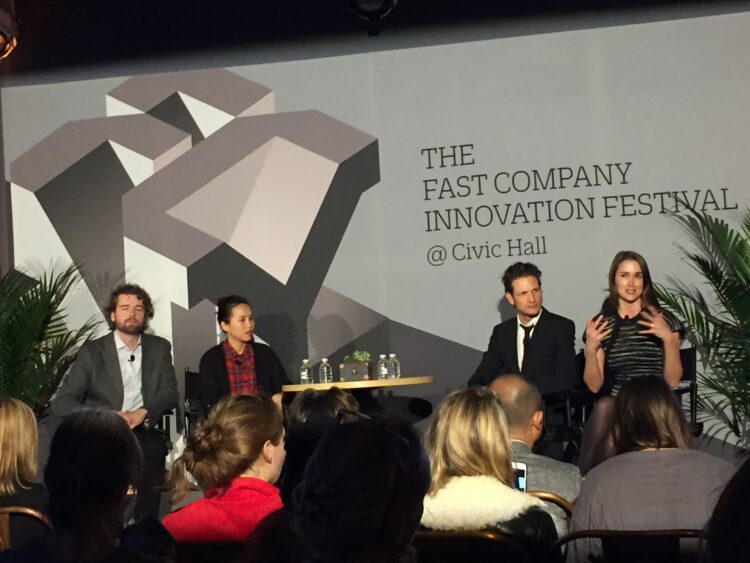
In mid-November New Yorkers and innovators from all over the country, and the globe, convened at trendy Civic Hall for the FastCoInnovation Festival. Spanning four days, two main locations (Skirball housed other speakers) and a multitude of site visits, the Festival featured dozens of speakers and panels focusing on tech, startups, and innovation in general.
I attended a few of the FastCo sessions, including two on fashion and retail. The first was on the Future of Retail, featuring Olivia Kim, Director of Creative Projects for Nordstrom, Uri Minkoff of co-founder of Rebecca Minkoff, and Rosie O’Neill, founder of Sugarfina. Focusing on the intersection of retail and technology, various topics were touched upon. Regarding designing retail stores around social media, the panelists had varied opinions. O’Neill explained that at Sugarfina, they specifically design stores with social media in mind, keeping the walls bright white and leaving little “surprises” around that are easily instagram-able. Minkoff, who of the three has the most tech-enabled store from the consumer-facing side, explained that they kept it in mind as well. They specifically curate events and experiences at Rebecca Minkoff stores that are interesting, different, and shareable, including having a yoga studio in their LA location as well as an art gallery at times. By curating experiences, Kim came from the perspective of the more established retail experience and while social media is not a prime concern of Nordstrom, they have also created moments you can share such as photo booths and gift making stations.
In regards to the online experience informing the in-store experience and visa versa, all the panelists were in agreement that it did. O’Neill said that Sugarfina learns how to make the online experience memorable from many of their in-store offerings such as customizable gift boxes. Kim cited how Jamie and Eric Nordstrom switched roles so they could both experience heading up in-store and ecommerce experiences to better inform the other. As for decide what tech to integrate to grow their companies, Minkoff shared that they focus on both the front end and back end of the business. On the front end, they are monitoring trends in social media and where the customer demand is, which is why they were one of the first brands on Instagram and snapchat. Kim shared that Nordstrom’s focus is customer service and communicating with the customer, so that’s where they focus their advancements, such as building an app that customers can directly chat with stylists. For O’Neill, she shared they care most about authenticity and using tech to show their consumers things they would never see. For example, she documented a recent trip to Italy on snapchat and was able to show her customers the tiny village their candy comes from and how it’s made. That’s something the customer would never experience, she explained.
I also attended the last of the Fastco Building Businesses That Matter panels, featuring Jenn Hyman, cofounder and CEO of Rent the Runway, and Bayard Winthrop, founder and CEO of American Giant. While they both started their companies stemming from different inspiration— Hyman from seeing her sister go into credit card debt to buy an evening gown and Winthrop being frustrated with the lack of US manufacturing— both are considered major disruptors in their industry and therefore face similar challenges. One of such challenges was skepticism early on. For Hyman, the evening gown brands she worked with thought her idea would dilute brand values as well as sales. Hyman convinced them (with a leap of faith!) that she would be increasing their total addressable market by millions of women. Turns out she was right— their customers are, on average, 25 years younger than the brands they carry’s customers.
For Winthrop, he cited challenges with his supply chain. He is dedicated to controlling the entire supply and production chain with American Giant, and was faced with the challenge of having to convince people that sourcing his entire supply chain in the US was possible.
They have taken different approaches to brick and mortar as well. Rent The Runway found it important to start opening a select number of stores as extensions of their fulfillment center as the store can guarantee a perfect experience (dress lost in the mail? they can deliver you one in 30 minutes). They also found it was much more likely to convert to sales for bigger, more important events. They found that no one wanted to risk getting a dress in the mail 3 days in advance for their sister’s wedding. But Hyman reiterated that the in-store experience complements the online experience, allowing you to try on many dresses and having that added to your account for future rentals.
Winthrop has avoided brick and mortar because of the expense associated with. He cited the modern day consumer as being more aware of costs than ever before— they would rather pay for a more expensive garment than a cheaper garment with the cost of rent integrated. Even so, Winthrop pointed out he has been able to get his manufacturing costs down to be competitive with China. Then he can pass those savings on directly to the consumers and make a nice margin to keep.
While Hyman is focused on product extensions— such as a rental for everyday clothing coming soon— Winthrop is focusing his efforts on really perfecting his supply chain and manufacturing processes.
Overall the energy at the FastCo Innovation Festival was high and the post-it’s ever abundant. They curated a great combination of different speakers and panels and attendees left with a wide range of exposure to many aspects of innovation.



